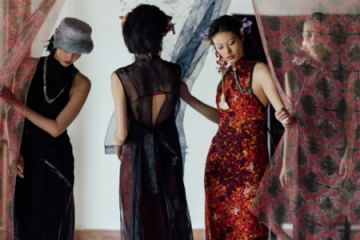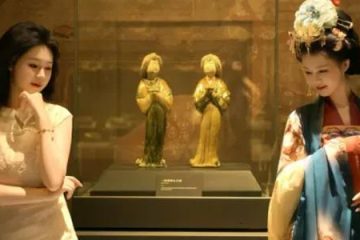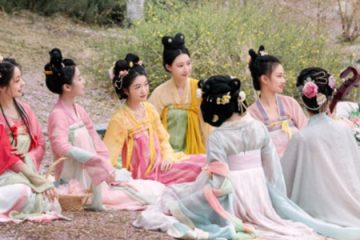When Did People Stop Wearing Hanfu?

Hanfu, the traditional clothing of the Han Chinese, has seen a major revival in recent years. With its flowing silhouettes, beautiful embroidery, and rich cultural roots, it’s no wonder more people are embracing Chinese dress both in China and around the world. But just like any culturally significant attire, there are moments when wearing Hanfu may not be the most appropriate choice.
Generally speaking, Hanfu is just like any other clothing—you can wear it in most everyday situations, and there are very few times it’s not suitable. In our previous posts, we talked about when and how to wear Hanfu well.
But just like any culturally significant attire, there are moments when wearing Chinese dresses may not be the most appropriate choice.
This post is all about the flip side: when it might not be the best choice. It’s here to help folks new to Hanfu quickly get the hang of the cultural etiquette around it. Let’s get started!
Ⅰ. Formal Work Settings (Unless Culturally Relevant)
Unless you work in a creative or cultural field where traditional attire is encouraged or accepted (like museums, cultural centers, or art-related events), Hanfu may not be suitable for a typical office environment. Most modern workplaces expect business or business-casual dress codes, and while Hanfu is beautiful, it can come across as costume-like or impractical in formal professional contexts.
Most people I see wearing Hanfu to work are younger folks, and they’re usually in more laid-back fields like the arts. If your office vibe is pretty chill, there’s no harm in giving Hanfu a try!

Ⅱ. Religious or Sacred Spaces (Outside Your Culture)
Wearing Hanfu to temples, mosques, churches, or other places of worship that are not part of your cultural background can raise questions of appropriateness. While Chinese style dress itself is not religious, wearing traditional attire in unfamiliar sacred spaces can sometimes be interpreted as performative or culturally insensitive, especially if you’re unfamiliar with the customs of that place.
Ⅲ. High-Risk Outdoor Activities or Crowded Transit
Wearing Hanfu on a hike, biking, or while navigating packed subways during rush hour might not be the best idea. Some styles of Hanfu feature long sleeves and flowing skirts that can get caught, trip you up, or make moving around difficult. Safety and practicality should always come first.
We’ve also talked before about what to do if you accidentally trip over your skirt or find it tricky to walk in Hanfu during your commute. There are two easy fixes: either hold up the hem when walking, or swap out long skirts for pants or shorter styles.
Here’s a tough lesson one girl learned the hard way: while go shopping, she got so caught up chatting with friends that she forgot to lift her mamian skirt. Before she knew it, the hem got dragged into the gap between subway platform edges and got stuck tight. She pulled twice but couldn’t free it—luckily, subway staff helped her get it out in the end. Thank goodness she was totally safe, but it’s a good reminder!

If you’re wearing floor-dragging Hanfu, always watch out for elevators, subways, and stairs—these are spots where accidents are more likely to happen.
Ⅳ. During Events That Could Misinterpret Cultural Expression
Sometimes, wearing Hanfu to politically charged events or in contexts where people might misinterpret it as a nationalistic or performative statement can be tricky. In some regions, traditional dress may carry unintended associations, and it’s important to understand the local social and political climate before dressing in Hanfu for public events.
For some, Hanfu is just a hobby—but those people who don’t get it can end up causing unexpected hassle in your day. It’s a good idea to skip wearing it during times when certain events are in full swing.
Ⅴ. If You’re Unprepared for Reactions
Wearing Hanfu in public can draw attention, especially outside of East Asia. If you’re not comfortable with stares, questions, or even the occasional ignorant comment, it might be best to ease into it in more welcoming spaces—like cultural festivals or Hanfu meetups—before going fully public.
I know lots of Chinese people wear typical Chinese dress to take photos abroad, and there are plenty of stories of locals complimenting them—saying they look elegant or like a princess. But a friend of mine told me that when she was studying overseas, no one paid much attention to her in regular clothes. But the second she put on Hanfu? The attention skyrocketed. (Let’s be real, people are curious!)
The thing is, some folks might look at you weirdly. Like, whispering behind your back that you’re an “attention wh*re.” (this word really hurts) So if you’re a shy person and don’t want to deal with that kind of flak, maybe think it through before wearing Hanfu out.

Summary
But are there times when wearing it actually has perks? Turns out, some people have shared some interesting observations: when traveling in Hanfu, it seems like the chance of getting pickpocketed is a bit lower. (To be clear, Hanfu’s just clothing, not some magic shield—thieves won’t suddenly go blind!) But from their personal experience, Hanfu might have offered a little extra protection for their belongings.
Chinese dressing is a stunning expression of heritage and identity. Like all traditional clothing, it deserves to be worn with care and context in mind. As the global interest in Chinese culture grows, wearing Hanfu can be a meaningful way to connect with the past—but it also comes with a responsibility to wear it thoughtfully.



0 Comments